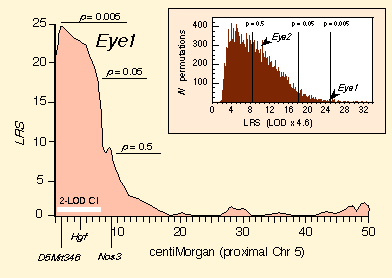 |
| |||||
|
| ||||||||
|
| ||||||||
Home  Publications Publications |
|
|
Genetics of Eye Size and Myopia This is a preprint of a paper that explores the genetic basis of variation in the growth of the mouse eye. The print edition was published in Investigative Ophthalmology and Visual Science, April, 1999.
Our aim is to develop mice as a model species for research on myopia. Myopia is casued by a comparatively modest overgrowth of the back part of the eye. We would like to know what genes and molecular mechanisms contribute to eye growth in general, and to the overgrowth of myopia in particular. This paper provide a lot of essential data on the size and growth of the normal mouse eye, lens, and retina. We've included a great deal of information on correlations among several important size parameters. For example, one might expect lens size and eye size to be tightly related in mice, but they are not. The print edition of this paper was published in a special myopia issue of Optometry and Vision Science (1999) 76:408 418. The retinoic acid receptors are expressed from early stages of development in the diverse tissues that make up the vertebrate eye. Their loss has subtle effects on eye development. We adapted sensitive quantitative trait locus (QTL) mapping methods to assess consequences of inactivating alleles of the alpha and beta receptors, Rara and Rarb, on eye and retinal development. Rara is of particular interest because this gene is a candidate for Nnc1, a QTL that controls retinal ganglion cell proliferation. See pdf file (2001) 7:253-260.
|
|
Neurogenetics at University of Tennessee Health Science Center
| Top of Page |
Mouse Brain Library | Related Sites | Complextrait.org

